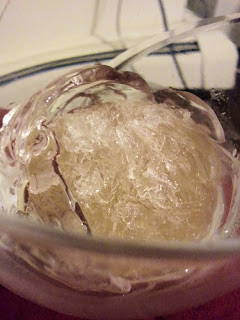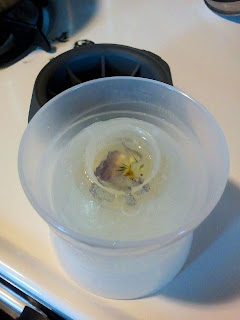 |
| Besides, how many of you were still getting snow last week? |
So....March's entry in the My Favorite Things project is one day late - and this is no April's Fool. I think it was worth it, though, to get the specs right. Again this month, I'm playing with technique, plus rarely-used tea ingredients and one of my favorite ingredients from my cabinet: rhubarb bitters!
Naturally there's one fitting lyric from My Favorite Things which best fits the month of March: Silver White Winters that Melt into Spring.
The name pretty much says it all: you start with Winter, and involve a component that melts, bringing with it notes of Springtime. Fancy ice is something I've been playing with for about half a year now, and this recipe pulls together elements already developed on various drinks: an ice sphere, filled with alcoholic ingredients, and alcoholic ingredients cut with water-based ingredients and then frozen. One realization that I've come to and implemented well with SWWTMIS is the secret to using flavored ice may be to find flavor combinations and ratios which will work at the outset and then at the tail end, that way the ice melt is one long fade between two controlled points.
But now then, let's dive into the recipe!
Silver White Winters that Melt into Spring, what you'll need
water
dried flower teas (lavender, linden blossom, elder flowers, etc..)
Hendrick's gin
plain vodka
white crème de menthe (for glass rinsing)
rhubarb bitters
edible flower or wild strawberry
Quick note on the spirits: I think Hendrick's especially suits the theme of the recipe, with its downplayed juniper plus rose and mellow cucumber notes. I recommend an eastern European vodka like my personal "house vodka", White Diamond, which is from Latvia. Eastern European vodkas tend to be known for their mineral notes, so it's nice to have something in stock which can bring that element.
 |
| Difference between ice shell and frozen filler. |
Brew floral tea
Make a pale but fragrant tea from dried flowers. Mix and match varieties, but try to include lavender as an ingredient because it pairs so well with the Hendrick's. I used 1/2 tsp each lavender, linden blossoms*, and elderflower blossoms to 8 oz boiling water. Let steep (preferably in a tea ball or tea strainer) until cool.*aka lime blossoms, aka tilia flowers.
Mix the filler
For each ice ball, mix 1 1/2 oz Hendrick's gin, 1 1/2 oz cooled floral tea, and 1 dash rhubarb bitters. Store in the refrigerator until ready to fill the ice ball.Ice ball
In a large ice ball mold, freeze plain water for about two hours or until a quarter to a third inch of ice is formed on the surface. Poke a small hole in the ball to drain the unfrozen water, but leave perhaps a quarter inch of water at the bottom for reinforcement. Place the shell back in the freezer for the reinforcement to freeze up, also adding the container of filler to the freezer -- the colder the filler is, to the point of ice crystals beginning to form, the less likely it will wear away at the ice shell as it's being added. |
| Why I advocate small fill-holes. Large holes like this are more difficult to cover over again. |
Once the garnish is in, go ahead and add the filler - a small/thin funnel may be useful here. Be mindful of what you touch -- the heat from your skin will enhance melting, and, vice versa, it's easy to get fingersicles fast!
The full 3 oz of the filler should be able to fit inside the sphere. You might want to practice the timing with plain water as a filler until you find the timing for an appropriate ice thickness that works for your freezer -- it'll be worth it for the flavor ratios to work, as well as the cocktail's overall alcohol level. If you've found your sphere has a little extra room after filling (without the filler being spilled on top - a problem for the drink's flavor), just add a little water to top it off.
Once the filler is in, return the ice ball to the freezer in its mold and let it freeze solid, about 4-6 hours (ok, maybe not that long, depending on your appliance, but be generous with the time you allot anyway, since the center has to develop ice crystals in the midst of alcohol).
Once the ice ball appears thoroughly frozen, drip a few drops of water on top of the fill-hole -- as you'll see in the bottom-most image, the ice ball will melt from the fill-hole outwards if not covered. Keep layering drops of water then freezing until the fill-hole is covered over. At this point the sphere is ready to use.
 |
| You really don't need me to give you a guide on how to add vodka to the drink, I was just especially pic-happy with this recipe. Also, pretty. |
To serve:
Rinse a chilled double old-fashioned glass with white crème de menthe (discard the remainder). Add your frozen ice ball. Pour one ounce vodka over the ice ball, swirl to start the melting, and sip to savor the emerging flavors.
At first you'll have the minerality of the vodka on your tongue, along with a sparkle of sweet mint. Then, perhaps imperceptibly, you'll find a hint of juniper, and a few moments later, something vaguely floral. The floral taste expands upon itself, sweetening (thanks to the tilia in the mix) with the lavender coming through better, and the wetness of the drink starts to stand out like chilly spring rains. You can tell the center of the ice ball really starts to take over when you taste the rhubarb bitters: spring has sprung! (even if there's still some late snow showers/vodka minerality)
It's not that far off from a Martini (but with more Old Fashioned ratios): you get added herbal and bitter components thanks to the floral tea and bitters, but less sour with slight sweet notes.